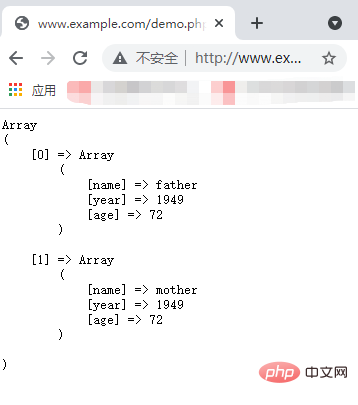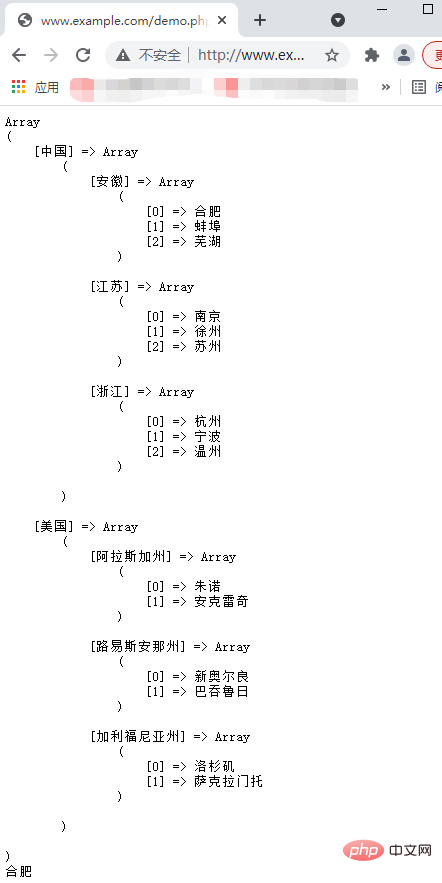 Backend Development
Backend Development
 PHP Problem
PHP Problem
 How to define a multidimensional array and obtain its elements in PHP?
How to define a multidimensional array and obtain its elements in PHP?
How to define a multidimensional array and obtain its elements in PHP?
In the previous article, I brought you "Take you through PHP filters in three minutes (detailed examples)", which introduced the relevant knowledge of PHP filters in detail. In this article, we Let’s take a look at the knowledge related to multi-dimensional arrays in PHP. I hope it will be helpful to everyone!

Through the previous study, we know that arrays in PHP can store all types of data, including of course the array itself. At this time, when the elements in one array are another array, what should we call the array that constitutes the containing array? When the elements in the contained array are still an array, how should we deal with it?
An array is simply a number or a simple list. Sometimes we want to use more than one key to save data. In this case, we need to use the included key we just mentioned. Array, this is called a multi-dimensional array. Next, let’s take a look at the relevant knowledge of multi-dimensional arrays.
Two-dimensional array
As we said above, when the elements in one array are another array, this The arrays that constitute the package function group are two-dimensional arrays, and two-dimensional arrays are simply understood as arrays of arrays. Is its declaration method any different from that of an ordinary array?
The declaration method of two-dimensional array and one-dimensional array is the same, except that one or more elements in the array are also declared as an array. At the same time, there are also direct assignment and use of array elements. The array() function has two ways of declaring a two-dimensional array.
Let's take an example to declare an array by directly assigning values to the array elements. The example is as follows:
<?php
$array[0]['name'] = 'father';
$array[0]['year'] = '1949';
$array[0]['age'] = '72';
$array[1]['name'] = 'mother';
$array[1]['year'] = '1949';
$array[1]['age'] = '72';
echo '<pre class="brush:php;toolbar:false">';
print_r($array);
?>Output result:

In the above example, an array is declared by directly assigning values to the array elements. Next, let’s look at declaring a two-dimensional array through the array() function. In the case of arrays, the example is as follows:
<?php
$array = array(
array('name'=>'father','year'=>'1949','age'=>'72'),
array('name'=>'mother','year'=>'1949','age'=>'72')
);
echo '<pre class="brush:php;toolbar:false">';
print_r($array);
?>The output result is consistent with the output result in the above example.
After declaring a two-digit array, it is very simple to obtain the elements. It is similar to a one-dimensional array. You only need to indicate the subscript of each dimension.
Next, let’s look at how to get the elements in the two-digit array through an example. The example is as follows:
<?php
$array = array(
array('name'=>'father','year'=>'1949','age'=>'72'),
array('name'=>'mother','year'=>'1949','age'=>'72')
);
echo '<pre class="brush:php;toolbar:false">';
print_r($array);
echo $array[0]['name'].'在'.$array[0]['year'].'年出生,今年已经'.$array[0]['age'].'岁了<br/>';
echo $array[1]['name'].'在'.$array[1]['year'].'年出生,今年已经'.$array[1]['age'].'岁了';
?>Output result:

What we need to pay attention to is: the different dimensions of the array indicate that we need to use several subscripts to get the corresponding array elements. For example, a two-dimensional array needs to use two subscripts to get the corresponding array elements, a three-dimensional array requires three, and so on.
Sometimes we want to use more than one key to save data, so we need to use PHP's multi-dimensional array to achieve it. However, sometimes you want to store values with more than one key. At this time, you can use multi-dimensional arrays for storage. Next let's take a look at multidimensional arrays.
Multi-dimensional array
In addition to two-dimensional arrays, PHP also supports three-dimensional arrays, four-dimensional arrays and even more multi-dimensional arrays, which can be collectively referred to here It is a multi-dimensional array, but when the array exceeds three dimensions, its readability will be greatly reduced, and it will not be easy to manage.
Refer to the two-dimensional array and draw inferences. You can easily create a three-dimensional array, a four-dimensional array, or other higher-dimensional arrays. Next, let’s take a look at how a three-dimensional array is defined through an example. The example is as follows:
<?php
$arr = array(
'中国' => array(
'安徽'=>array('合肥','蚌埠','芜湖'),
'江苏'=>array('南京','徐州','苏州'),
'浙江'=>array('杭州','宁波','温州')
),
'美国' => array(
'阿拉斯加州'=>array('朱诺','安克雷奇'),
'路易斯安那州'=>array('新奥尔良','巴吞鲁日'),
'加利福尼亚州'=>array('洛杉矶','萨克拉门托')
)
);
echo '<pre class="brush:php;toolbar:false">';
print_r($arr);
echo $arr['中国']['安徽'][0]; // 输出合肥
?>Output result:

The above example is The definition of multidimensional arrays and how to obtain elements in multidimensional arrays.
If you are interested, you can click on "PHP Video Tutorial" to learn more about PHP knowledge.
The above is the detailed content of How to define a multidimensional array and obtain its elements in PHP?. For more information, please follow other related articles on the PHP Chinese website!

Hot AI Tools

Undresser.AI Undress
AI-powered app for creating realistic nude photos

AI Clothes Remover
Online AI tool for removing clothes from photos.

Undress AI Tool
Undress images for free

Clothoff.io
AI clothes remover

AI Hentai Generator
Generate AI Hentai for free.

Hot Article

Hot Tools

Notepad++7.3.1
Easy-to-use and free code editor

SublimeText3 Chinese version
Chinese version, very easy to use

Zend Studio 13.0.1
Powerful PHP integrated development environment

Dreamweaver CS6
Visual web development tools

SublimeText3 Mac version
God-level code editing software (SublimeText3)

Hot Topics
 CakePHP Project Configuration
Sep 10, 2024 pm 05:25 PM
CakePHP Project Configuration
Sep 10, 2024 pm 05:25 PM
In this chapter, we will understand the Environment Variables, General Configuration, Database Configuration and Email Configuration in CakePHP.
 PHP 8.4 Installation and Upgrade guide for Ubuntu and Debian
Dec 24, 2024 pm 04:42 PM
PHP 8.4 Installation and Upgrade guide for Ubuntu and Debian
Dec 24, 2024 pm 04:42 PM
PHP 8.4 brings several new features, security improvements, and performance improvements with healthy amounts of feature deprecations and removals. This guide explains how to install PHP 8.4 or upgrade to PHP 8.4 on Ubuntu, Debian, or their derivati
 CakePHP Date and Time
Sep 10, 2024 pm 05:27 PM
CakePHP Date and Time
Sep 10, 2024 pm 05:27 PM
To work with date and time in cakephp4, we are going to make use of the available FrozenTime class.
 CakePHP File upload
Sep 10, 2024 pm 05:27 PM
CakePHP File upload
Sep 10, 2024 pm 05:27 PM
To work on file upload we are going to use the form helper. Here, is an example for file upload.
 CakePHP Routing
Sep 10, 2024 pm 05:25 PM
CakePHP Routing
Sep 10, 2024 pm 05:25 PM
In this chapter, we are going to learn the following topics related to routing ?
 Discuss CakePHP
Sep 10, 2024 pm 05:28 PM
Discuss CakePHP
Sep 10, 2024 pm 05:28 PM
CakePHP is an open-source framework for PHP. It is intended to make developing, deploying and maintaining applications much easier. CakePHP is based on a MVC-like architecture that is both powerful and easy to grasp. Models, Views, and Controllers gu
 How To Set Up Visual Studio Code (VS Code) for PHP Development
Dec 20, 2024 am 11:31 AM
How To Set Up Visual Studio Code (VS Code) for PHP Development
Dec 20, 2024 am 11:31 AM
Visual Studio Code, also known as VS Code, is a free source code editor — or integrated development environment (IDE) — available for all major operating systems. With a large collection of extensions for many programming languages, VS Code can be c
 CakePHP Creating Validators
Sep 10, 2024 pm 05:26 PM
CakePHP Creating Validators
Sep 10, 2024 pm 05:26 PM
Validator can be created by adding the following two lines in the controller.





